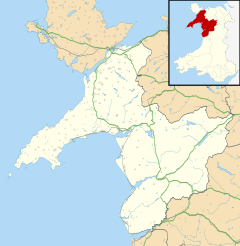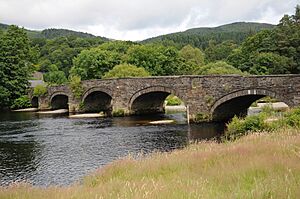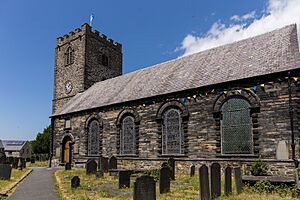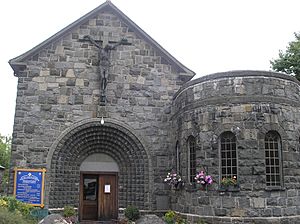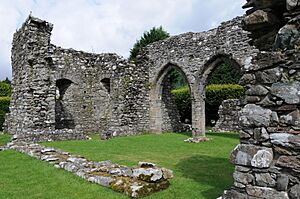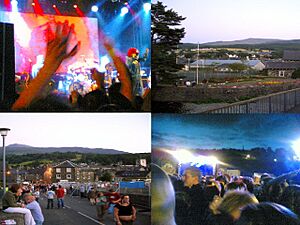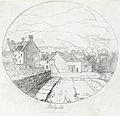Dolgellau facts for kids
Quick facts for kids Dolgellau |
|
|---|---|
 Eldon Square, Dolgellau |
|
| Population | 2,688 (2011 census) |
| OS grid reference | SH728178 |
| Community |
|
| Principal area | |
| Ceremonial county | |
| Country | Wales |
| Sovereign state | United Kingdom |
| Post town | DOLGELLAU |
| Postcode district | LL40 |
| Dialling code | 01341 |
| Police | North Wales |
| Fire | North Wales |
| Ambulance | Welsh |
| EU Parliament | Wales |
| UK Parliament |
|
| Welsh Assembly |
|
Dolgellau is a town in Gwynedd, north-west Wales. It sits by the River Wnion, which flows into the River Mawddach. This town was once the main town for the historic area of Merionethshire. Today, Dolgellau is a popular spot for people who want to climb Cadair Idris and Mynydd Moel. These mountains can be seen right from the town! It's the second largest town in southern Gwynedd, after Tywyn.
| Top - 0-9 A B C D E F G H I J K L M N O P Q R S T U V W X Y Z |
What Does Dolgellau Mean?
The name Dolgellau comes from two Welsh words. Dôl means 'water-meadow', which is a grassy field near water. Cellau means 'cells' or 'stalls'. So, the name means 'water-meadow of cells'.
The 'dôl' part likely refers to a bend in the river where the Wnion and Aran rivers meet. The 'cells' might have been small rooms for monks or stalls for merchants.
The earliest way the name was written was Dolkelew in 1254. Later, people often spelled it Dolgelly or Dolgelley in English. But in 1825, the spelling Dolgellau became common. This is now the official name.
A Look Back: History and Economy
Long ago, before the Romans came, the area around Dolgellau was home to a Celtic tribe called the Ordovices. The Romans took over in AD 77–78. Even though some Roman coins were found, there's no sign they settled here. However, there are three old hill forts nearby.
After the Romans left, Welsh leaders ruled the area. Dolgellau itself probably started as a small village around the 11th or 12th century. It was a "serf village," meaning people worked for a local lord.
A church was built in the 12th century. But Cymer Abbey, a religious center founded in 1198 nearby, was very important. Dolgellau grew in importance. In 1404, the Welsh leader Owain Glyndŵr held a meeting of chiefs here.
In 1657, many people in Dolgellau became Quakers. Because they were treated unfairly for their beliefs, many moved to Pennsylvania in America in 1686. A town there, Bryn Mawr, is named after a farm near Dolgellau.
For a long time, making wool was very important to Dolgellau's economy. But when new machines were invented, the wool industry slowed down. Making leather was also a big business here until the 1980s.
In the 1800s, Dolgellau had a small gold rush. Over 500 people worked in the local gold mines at one point. Gold from mines like Clogau St. David's has even been used for royal weddings!
Dolgellau was the main town of Merionethshire until 1974. Today, the town mostly relies on tourism. People come to visit the beautiful countryside. Farmers also sell their goods at a market in the town center every month.
The Dolgellau Cricket Club started in 1869. It's one of the oldest cricket clubs in Wales! For almost 100 years, Dolgellau was home to Dr Williams School, a special secondary school for girls.
Learning in Dolgellau
Dolgellau has a bilingual college called Coleg Meirion-Dwyfor. It's built on the site of the old Dr Williams' School. This school for girls opened in 1878. It was named after Daniel Williams, a religious leader from the 1600s. The school closed in 1975.
There was also a boys' school called Dolgellau Grammar School, started in 1665. In 1962, it became a bigger school called Ysgol y Gader. This name means "School of the Chair," referring to the mountain Cadair Idris.
In 2017, Ysgol Y Gader joined with the local primary school and seven other schools. They formed a new school for students aged 3 to 16, called Ysgol Bro Idris. As of 2019, it had 581 students. The school teaches most subjects in Welsh.
Dolgellau in Books
Near Dolgellau is a house called Hengwrt. In the 1600s, its owner, Robert Vaughan, had a huge library. It held many old and important handwritten books. These included the Book of Aneirin and the Black Book of Carmarthen. Most of these books are now kept at the National Library of Wales.
John Elwyn Jones, a teacher from Dolgellau, wrote a book called Pum Cynnig i Gymro (Five Tries for a Welshman). It's about his time as a prisoner during World War II. He tried to escape five times, and the last time he succeeded! He also wrote about growing up near Dolgellau.
Marion Eames, who went to Dr. Williams' School, lived in Dolgellau. She wrote The Secret Room, a story about the Quakers who left Dolgellau for America in 1686.
Fun Things to Do in Dolgellau
The area around Dolgellau is famous for its wild and beautiful scenery. It's a great place for tourists who love outdoor activities. You can go hiking, horse riding, white-water rafting, and climbing. Dolgellau is the main starting point for climbing Cadair Idris. People who love airplanes also use the town as a base to watch planes in the Mach Loop.
To the north, you can find the Dolmelynllyn Estate. It has walking paths that lead to the Rhaeadr Ddu waterfall and old gold mines.

The old railway line from Dolgellau was closed in the 1960s. Now, it's a path called the Llwybr Mawddach (or "Mawddach Trail"). This path is about eight miles long and goes from Dolgellau to Morfa Mawddach railway station near the coast. It's perfect for walkers and cyclists. You can see many water birds along the way.
The old Dolgellau railway station site was used to build a bypass road in the 1970s.
Besides the town itself, you can visit Cymer Abbey. This old abbey from the 12th century is a short walk from Dolgellau. The tourist center also has information about the Quakers and their old graveyard in town.
Dolgellau is also a good place to visit several nearby narrow-gauge heritage railways. These include the Corris Railway, the Fairbourne Railway, and the Talyllyn Railway.
Festivals and Events

Sesiwn Fawr Dolgellau
Since 1992, Dolgellau has hosted Sesiwn Fawr Dolgellau. This means "The Great Session of Dolgellau." It's an annual world music festival. It started as a free event in the streets. Now it's bigger and held outside the town, with tickets needed. Famous musicians like Cerys Matthews and Super Furry Animals have played there. It attracts thousands of people each year.
Gwyl Cefn Gwlad
Every summer, Dolgellau also has Gŵyl Cefn Gwlad, which means "Festival of the Countryside." It's like a mix of a farm show and a fun fair. Entry is free, and money raised goes to good causes.
Eisteddfod
Dolgellau has hosted important Welsh cultural festivals called Eisteddfods. It hosted the National Eisteddfod of Wales in 1949. It also hosted the Urdd National Eisteddfod for young people in 1960 and 1994. The old market hall, Neuadd Idris, is now the National Centre for Folk Music, called Tŷ Siamas.
Twin Town
Dolgellau is connected with another town in a special friendship called "twinning." Its twin town is:
 Guérande in Brittany, France.
Guérande in Brittany, France.
Famous People from Dolgellau
Many interesting people have connections to Dolgellau:
- Sir Robert Vaughan, 2nd Baronet (1768–1843) was a landowner and politician.
- Thomas Richards (1800–1877) was a surgeon and writer.
- Mary Morris (1873–1925) was a doctor and a suffragette.
- Marion Eames (1921–2007) was a Welsh novelist.
- Ioan Bowen Rees (1929–1999) was a Welsh poet and mountaineer.
- Alan Llwyd (born 1948) is a well-known Welsh poet.
- Gwyndaf Evans (born 1959) is a rally driver who won the British Rally Championship in 1996.
- Martin Philips (born 1960) is a Welsh darts champion.
- Elfyn Evans (born 1988) is also a rally driver, and Gwyndaf Evans's son.
Images for kids
See also
 In Spanish: Dolgellau para niños
In Spanish: Dolgellau para niños


